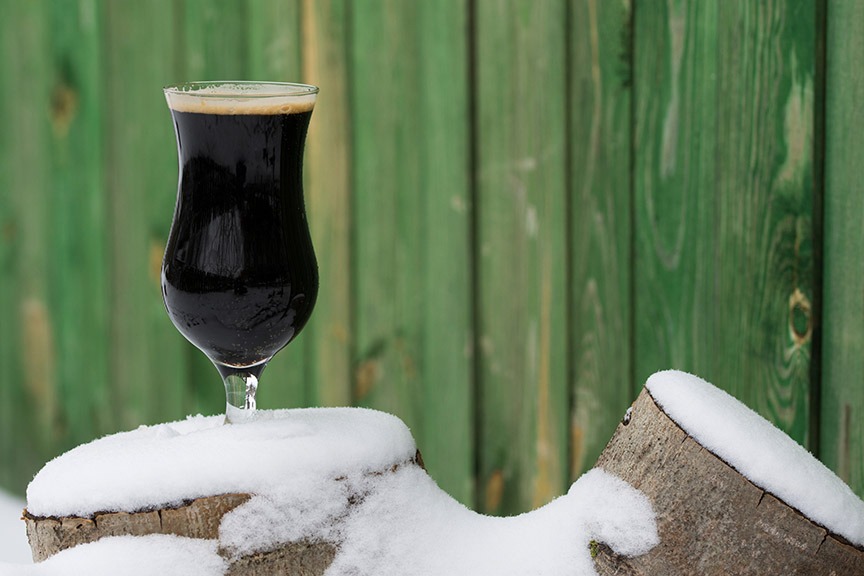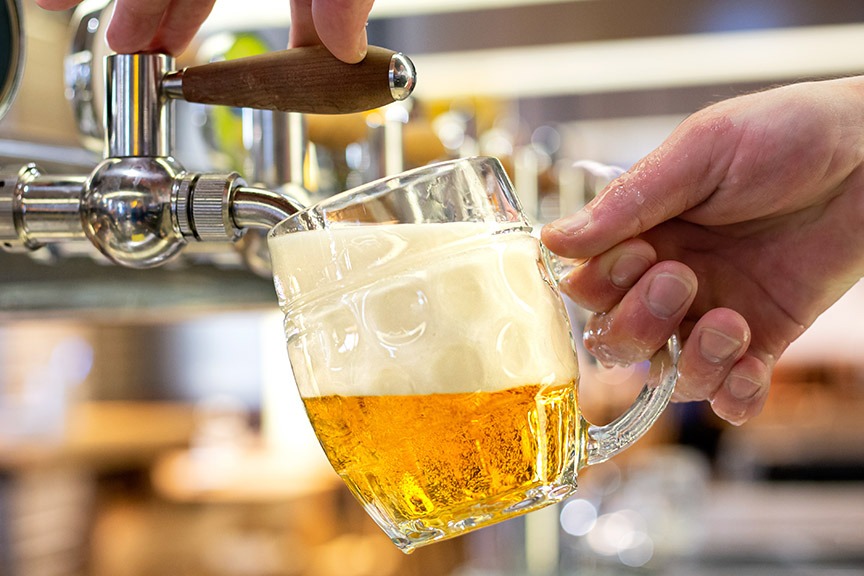Testing New Malts
Despite this being the age of the hop, maltsters are bound and determined to not let the lupulin farmers have all the fun. We’re nearly buried under mountains of new grains and varieties that promise something special. To confidently choose from this giant pile of ingredients, we’ve preached practical experience for best results and insights into what a new toy gives our brews.
But even the most ambitious amongst us will discover that keeping pace with the deluge is akin to King Canute commanding the tide. Surely there must be an easier way to gain the malty knowledge we need!
Would you be surprised if we said, “Why, yes . . . yes there is!” After all, this would be an awfully short monograph if we didn’t! Before we dive headlong into processes and procedures, let’s discover why we need to develop our grain “vibing” skills.

What’s New in Grain
First, The Old
With rare exception (looking at you, Maris Otter), barley varieties constantly change. Just like every big bright red summer tomato isn’t a “Beefsteak,” your “pale malt” might be made of varieties like Conrad, Expedition, Odyssey, and more. The American Malting Barley Association releases an annual list with recommended varieties. The 2024 edition contained more than 40 recommended barley crops.
This explains why you’ll see older grain bills that list “Klages” or “Harrington” – two popular varieties introduced in the ‘70s and ‘80s. But as growers’ needs change (yield, disease-resistance, drought- and temperature-tolerances, etc.), they plant new varieties to meet customer demand.
“Flavor” is not in that list because in modern agronomics, a matter of taste rarely matters. This change makes recreating historical recipes a dicey proposition since you can’t start with the same grains . . . until recently. Several maltsters — Crisp and Weyermann among the largest — have planted select heritage crops bringing back old varieties with different flavor impacts at a premium price.
Craft maltsters like Sugar Creek are in the game releasing Edelweiss, an old Pilsner malt. It’s a trip to make an IPA with “the original IPA malt” (Crisp Chevallier®), but given their dearness, you want to use them to their utmost.
Now, The New
Naturally, not all of the grainy goodness is looking to the past. New malts and malt types are being released all the time. Like the recent rise of “red” malts hitting the market to simplify making bold red beers without the color variability or hint of roasted coffee added by the traditional skosh of black malt. Different forms of crystal malts with new flavor profiles. Even new base malts designed for modern needs (see Gambrinus IPA Malt or lager malts with softer levels of classic Moravian malt flavors). And new adjuncts galore like malted corn or variants of malted oats or even wilder grains new to the brew kettle.
Plus, the craft malt scene adds layers of terroir and differing technique to the mix! With so many new options out there, it’s time to try something different.
Taking the Malt Challenge (from easiest to hardest)
How do you make a beer with a new malt without wasting your time or your beer? After all, we only get so many brew days and we want to maximize their utility. We’ll give you a few quick and easy methods, one medium effort bit of nerdery, and then finally walk through the one true way to know.
Hit the Books
We are card carrying nerds of the type with fond memories of hours spent riffling the card index searching for information. Today, it’s so easy to grab data that we neglect to think of it as a real effort. But in this case, it absolutely is where you start. Malt companies want you to use their products and they know it’s a confusing landscape. On their websites you’ll find the base numbers (gravity, color, protein, etc.) and descriptions you need to form a basic opinion. If you’re visually oriented, look for spider graphs that chart tasters’ perceptions.
Some websites will also list things like suggested uses — styles and amounts — but don’t feel constrained by them. One of us (guess which) kinda purposefully pivots away from suggestions out of sheer stubbornness. “Oh, this is the original IPA malt? How about I make a mild with it?” (Incidentally, that was a great mild.)
If the info you need isn’t handy, reach out to the maltster directly with your questions.
The truth is also out there buried in the opinions of your fellow brewers and if you know anything about brewers, they love to talk beer. Find a commercial brewer that makes a beer with the target grain. Ask online forums, phone a friend, etc. This is a good starting point, but you’re brewing for your preferences, so at some point you’re going to need to put the grain where your mouth is.
Tasting
After reading and researching you should have an inkling of an idea or a plan, but words are not organoleptic reality, plus you may randomly discover a grain when you walk into your local brew shop (remember those?). The great search engine in your pocket may get you started but the first way to suss out a malt’s character is thankfully the easiest and a test you should be doing on the regular anyways. Taste them!
A good homebrew store allows you to grab grain from bulk bins and buckets. Ask if they mind you sampling a few grains here and there. We’ve yet to encounter a shop that begrudges curious nibbles. This is not an all you can eat cereal bar — your intention is discovery, not gluttony. Grab four or five kernels and give them the once over — physically, visually, and aromatically. What does the grain feel like? Is it hard, soft, or glassy like a crystal malt? Is the color uniform across the sample? Is it possibly a blend of grains? What do you smell? Spices, earth, dust, or must? Does it smell of fresh bread dough or toast?
Then commit to violence — pop the kernels into your mouth and crush them open. DON’T SWALLOW. Let the partially powdered grain sit on your tongue, soaking in saliva. As you wait 30 seconds or so, you’ll feel a shift. The malt transforms in your mouth via the amylase enzymes in the saliva. Starches get transmuted into sugars and flavors open up.
What do you taste? As with all things sensory – tie it back to images and sensations you know. It’s OK to think things like “Cocoa Puffs,” “Maris Otter, but more so,” or “Burnt toast and Munich malt.” These images/phrases form the functional foundation of what you need to effectively use these new ingredients. Tying new ingredients to items you already use helps guide you. This test also refreshes your sense memory for ingredients you already know.
If you’re ambitious, try a proportional test. Grab 20 kernels of grain in a mix that reflects how you’d use them in a beer — say, 18 pale malt and two of the new stuff (a 90/10 split) and repeat the test. What do you perceive this time?
Fill out the mental index card and file it in the stacks for future use.
Grain Tea
Eating the grain is a good way to get your start, but at some point, it’s just not complete enough. If you have multiple malts to compare, then it’s also not terribly efficient. Fortunately, Briess has given us a fairly easy method to test called the hot steep method — aka grain tea!
While hot barley tea is a thing in a number of countries, it’s not here — except with brewers mixing wort with Scotch (aka the Hot Scotchy) as a cheeky breakfast beverage. In 2015 Briess teamed up with Lindsay Barr, now of Draught Lab, to create a standardized method of creating malt teas for sensory evaluation.
Since this is also an American Society of Brewing Chemists (ASBC) test (ASBC Sensory Analysis 14 Hot Steep Malt Sensory Evaluation), the method is rigidly proscribed. What it boils down to is pretty simple though:
• Take 52 g of malt (either 100% base malt, 50/50 of base and specialty, or 85/15 of base and dark roasts) and blend it into powder, husk and all.
• Mix 50 g of the grain dust with 400 mL of water at 149 °F (65 °C) in a jug.
• Steep for 15 minutes.
• Run the steeped liquids after 15 minutes through a fine paper filter (such as a coffee filter).
• Once collected, allow to cool to room temperature and sample. Take copious notes of the aroma, flavor, and color sensations.
In other words – create a very small mash, convert the starch, strain the wort, taste.
That’s a very quick summary, but full instructions can be found on Briess’s website here. But remember the reason these tests have precise instructions is to ensure that the sensory lab produces reliable results with repeatable methodology. In other words, it’s not the only way to steep a cereal. For home use, create your own method with what you have on hand. As long as you can “mash, convert, strain” on a small scale with consistent measures. Go for it! Drew’s been known to hold jars of mini mashes warm in a sous vide bath, because he’s obsessed with foodie hot tubs.
Making malt tea is more time consuming than chomping on a few kernels, but it’s still straightforward, cheap, and effective for exposing the impact of a grain. And yet . . .

Brew It Real Good
Ultimately, the one true path to ingredient wisdom is to brew. You have a few paths laid out before you – the “purely scientific route,” the “tweener route,” or the “we’re doing it live” route.
The scientific route looks a lot like the Briess hot steep method, but completing the brew day. Make a simple recipe with basic base malt and your target malt. We used our Magnum Blonde Ale (recipe to the right) for testing a number of hypotheses and what’s “the impact of this grain” if not a testable question? Mid-weight gravity, moderate neutral bittering, with neutral fermentation characters. To test specialty grains, sub in a portion of the attached recipe’s bill for your new grain. Say 10% for an assertive malt and up to 50% for less assertive grains.
Trust us when we say this beer is almost aggressively neutral and therefore perfect for accentuating any changes to ingredients or process. If you want to truly go full science nerd, brew a control batch with no adulterations to serve as a clear baseline. Differences will stand out like a candle lit in a darkened room.
For the in-between route, and honestly the approach we take most often, take a recipe you know intimately, the kind that is settled in your bones, and add the new grain in there. The hope is to be able to discern the impact of the new grain you’re trying out but also brewing a beer that is a good fit for that grain and will result in a beer you’ll be happy to consume an entire batch of (over the course of time). Drew’s been doing this for yeast and grains for years with his Saison Experimentale and his Cream Ale. Denny makes tweaks to Wry Smile Rye IPA or others. It’s not the most scientific, but it’s useful as a bench trial of a real application to our brewing world. Just choose a recipe where the kind of grain you want to learn about is relevant.
Lastly, there’s the classic homebrewer method — flying by the seat of our inflammable pants. You could totally wing a new recipe. After all, why not? It’s only beer. But even when you’re testing the drag coefficient of your trousers, try and keep an eye towards the learning. How will you pick out what this one “new to you” ingredient does? Are you showcasing it? If it’s blended in with other new/forceful ingredients, you’re going to have a devil of a time picking out each addition’s impact. But this is homebrewing, if you’re not having fun by forcing yourself into a final exam reminisce, what’s the point? Fly that daredevil spirit, you just might have to repeat your lessons like a recalcitrant pupil. Wait, more beer? Hmm . . . maybe we should do more “experiments” like that.
Two last thoughts before we leave you to your grain explorations. Don’t be afraid to brew small — your learnings are just as valid whether you’re making one gallon (3.8 L) or a hundred (380 L). Lastly, don’t get overly exuberant with your new toys. Using too much of an ingredient can blur the knowledge you want for day-to-day brewing.
Now go and find your new favorite ingredient!
Magnum Blonde Ale
(5 gallons/19 L, all-grain)
OG = 1.047 FG = 1.010
IBU = 45 SRM = 3.4 ABV = 4.8%
This recipe makes an extremely neutral blonde ale and is a great base recipe for experimenting with new ingredients. Replace a reasonable amount of the base malt with another base or specialty malt at a one-to-one ratio.
Ingredients
9.7 lbs. (4.4 kg) North American 2-row pale malt
8 AAU Magnum hops (60 min.) (0.7 oz./20 g at 11% alpha acids)
8 AAU Magnum hops (20 min.) (0.7 oz./20 g at 11% alpha acids)
Wyeast 1056 (American Ale), WLP001 (California Ale), SafAle US-05, or LalBrew BRY-97 yeast
¾ cup corn sugar (if priming)
Step by step
Use the Bru’n Water “Balanced Yellow Water Profile.” Mash your grain at 152 °F (67 °C) for 60 minutes. Mash out and collect about 6 gallons (23 L) of wort. Boil 60 minutes, adding hops as indicated. Cool, pitch yeast, ferment, and package.
Extract option: Replace the 2-row pale malt with 5.25 lbs. (2.4 kg) light dried malt extract or 6.5 lbs. (2.9 kg) light liquid malt extract. Heat 6 gallons (23 L) of water in your kettle, steeping any specialty grains you would like to trial. At 170 °F (77 °C), remove the grains and bring to a boil. Following the remainder of the all-grain recipe. You do not need to reduce the extract when steeping specialty grains.






